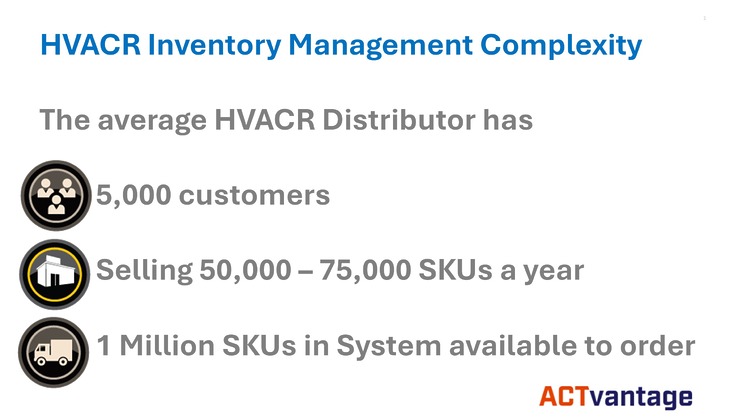
Managing your inventory is the key to drive top-line sales and gross margin performance in 2025 –
In a recent discussion with Brent Johnstone from ACTvantage we talked about how industrial distributors can increase gross margin without hurting top-line sales in 2025. When we both started into distribution, the prevailing thought for distributors and manufacturers in the B2B Distribution Channel was as follows:
- To grow top-line sales above market you have to sharpen the pencil and reduce Gross Margin percentage.
- Increasing prices can increase short term profits, but will curtail top line sales growth in the long run.
We know that the above statements have hyperbole, but in general, I think they are accurate in terms of how most associates in the industrial channel think. If you ask for higher prices, you’ll decrease sales volume.
However, I believe you can achieve margin expansion and above-market sales growth because most channel partners have process gaps to address. Distribution margin is a proverbial leaky bucket because of the complexity of the process.
*The above graphic illustrates the complexity of managing the intersection of pricing, inventory, customer, and supplier data to have the “right inventory” mix.
This complexity always creates areas where, with data, you can improve your business in three key areas.
- Purchasing (buy-side) and buying better – Almost every channel partner sales team thinks their team is buyers (restockers) vs. purchasers (strategic supply managers).
- Pricing (sell side) to win more often – Sales teams typically agree that their teams do not deliver a “market price” that allows them to win without discounting.
- Inventory levels (you need it, we got it) – Breadth and Depth of Same-Day and Next-Day Inventory is where most sales leaders in the channel feel their business needs improvement.
In this article, we will cover some critical areas for consideration; let’s start with this universal truth in distribution.
If your customers believe you have the right inventory to serve them, it gives you the foundation to grow both Sales and Margin.
For Industrial having the right “Next Day” inventory is crucial for your end users. If you can improve your “Next Day” inventory position you have the foundation for above market growth in 2025.
So, where do you start on a journey to improve your inventory?
We recommend you follow some proven steps. (Thank you to the team at ACTvantage for sharing some of their process for improvement)
ACTvantage Playbook – Inventory/S&OP (“Fusion”) Decision Tree
I love this approach; it offers a framework you can adopt in your business. ACTvantage shared the following:
- Start your analysis at your Category level – e.g., Controls, Motors, HVACR equipment, Parts and supplies, etc.) and then dive deeper into….
What are the key factors driving your Inventory Rank metrics
- Look at your GMROII vs. other categories and what it would take to improve. GMROII is your Gross Margin Return on Inventory Investment, a ratio that shows how much gross profit you generate for each dollar of inventory you carry.
- Break GMROII into constituent components for a deeper dive:
- Look at GM$ levels and trends vs. other categories (and relative impact on GMROII) and what might be driving underperformance.
- Examine your relative sales $ levels and trends (and impact on GM$)
- Look at relative margin levels and trends (and effect on GM$)
- COGs levels and trends (Are you experiencing higher per-unit costs/inflation from suppliers?)
- Pricing trends: Do margins follow a typical pattern, or is there something odd that could indicate competitive dynamics not present in other categories? Look at typical pricing factors to see if they align with expected margins: demand elasticity, Unit Prices, product “visibility,” and availability.
- Examine your inventory levels (% of D inventory and its relative impact on GMROII)
- Once you’ve analyzed each component of GMROII, break your inventory into “sub-buckets” within each inventory rank (A/B/C/D) and engage best practices to determine what it would take to improve inventory ranks within each bucket (i.e., what combination of sales effort, supplier negotiation, pricing, and inventory reduction).
- Look at GM$ levels and trends vs. other categories (and relative impact on GMROII) and what might be driving underperformance.
Another step in this process will lead you to inventory workflow decisions that tie to the number of customers that purchase each SKU.
For example – You could analyze all the D inventory that customers have not purchased in the last 8 months, or you could investigate “at risk” inventory purchased only by one or two customers. This type of inventory analysis will likely help you with supplier and customer discussions/negotiations.
Without understanding those intersections (customer and inventory) and making data-driven decisions, your inventory optimization process will have gaps.
It all begins with your process. Once you map and understand your inventory processes, you can take steps to look one level deeper once critical factors are isolated.
Then, you can work on whether you can improve your inventory with better supplier selection, better supplier negotiation, analysis at the customer level, improved pricing, and so on.
It is difficult to do this in an internal silo, in my opinion, without examining best practices from experts like ACTvantage (Analytics Tools & Training for the Distribution Industry) or considering an educational program from ISA.
If you need some out-of-the-box thinking on inventory for 2025, I recommend considering outside training and support.
As always, I appreciate your comments and feedback.


Leave a Reply